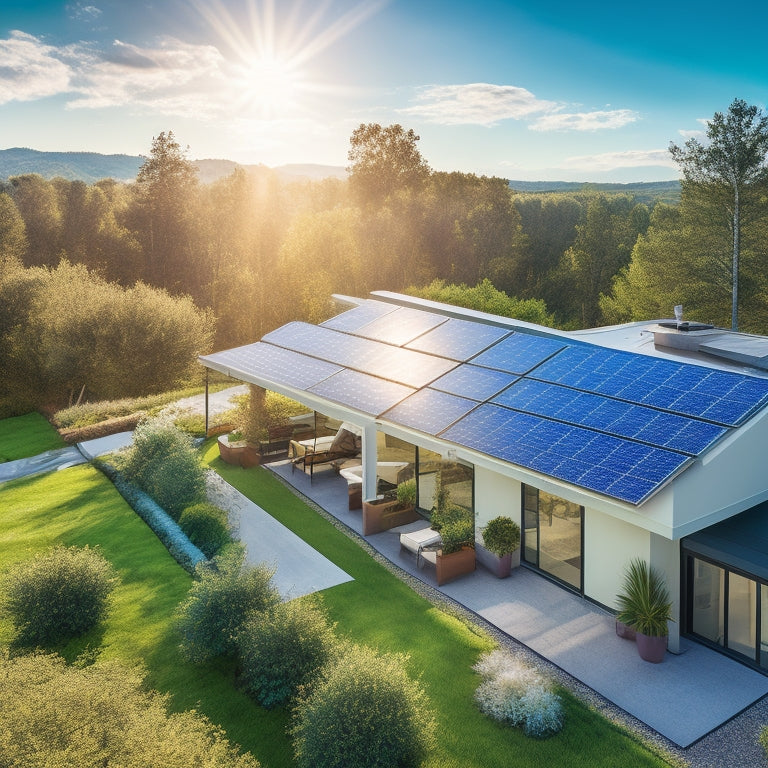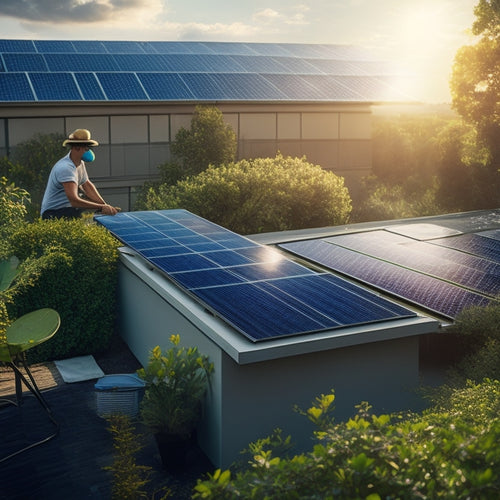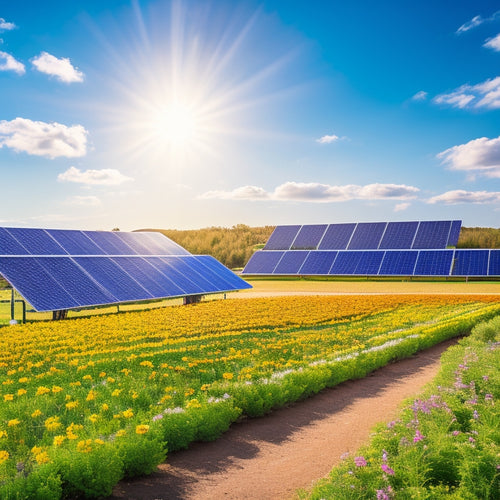
What Are the Top Rated Solar Panels Online?
Share
When searching for top-rated solar panels online, focus on Panasonic and Canadian Solar. Panels with over 20% efficiency, like high-efficiency monocrystalline models, are excellent for energy independence. Guarantee they have a robust performance warranty of 20-25 years. Check customer reviews for insights into real-world performance and reliability. Quality panels often withstand harsh weather and offer sleek designs like black-on-black or frameless options. Prices vary, typically from $0.50 to over $1.00 per watt depending on quality. Panels featuring pre-assembled components and user-friendly installation guides simplify setup. Explore further to understand how these factors guarantee top-tier solar performance.
Key Takeaways
- High Efficiency: Panels with over 20% efficiency, like those from Panasonic, are top-rated for maximizing electricity generation.
- Durability and Warranty: Panels offering 20-25 year performance warranties, such as those from Canadian Solar, ensure long-term reliability.
- Customer Reviews: Positive feedback on ease of installation and performance boosts the ratings of brands like LG and SunPower.
- Brand Reputation: Established brands with a history of innovation and sustainability, like Panasonic, are highly regarded.
- Installation Features: Panels with pre-assembled components and user-friendly manuals, like those from Renogy, are favored for quick and easy setup.
Efficiency and Output
https://www.youtube.com/watch?v=i1KUSwEjosg
Evaluating the efficiency and output of solar panels is essential because these metrics determine how much electricity you can generate from the available sunlight. To maximize your energy independence, consider panels with high efficiency ratings. Efficiency indicates the percentage of sunlight converted into usable electricity. Premium panels often exceed 20% efficiency, while standard models range between 15-18%.
Temperature coefficients are critical in evaluating panel performance. Solar panels' efficiency drops as temperatures rise. For example, a panel with a temperature coefficient of -0.4%/°C will lose 0.4% efficiency for every degree Celsius above 25°C. Lower temperature coefficients are preferable, ensuring more stable performance in hot climates.
Light sensitivity, or irradiance performance, also affects output. Panels with high light sensitivity can generate more electricity under low-light conditions, such as during cloudy days or early mornings. Look for panels with strong performance in varied lighting to secure consistent energy production.
Durability and Lifespan
When evaluating solar panels, you should consider their weather resistance and performance warranty. High-quality panels often come with robust weather-resistant features, ensuring they withstand harsh conditions.
Additionally, a strong performance warranty, typically ranging from 20 to 25 years, guarantees long-term reliability and efficiency.
Weather Resistance
How do top-rated solar panels withstand extreme weather conditions and maintain their durability and lifespan over time?
These panels incorporate advanced materials and engineering to guarantee resilience against the elements.
A key feature is a waterproof coating. This layer protects the photovoltaic cells from rain, snow, and humidity, effectively preventing water ingress that could compromise the panel's functionality.
The waterproof coating is rigorously tested to meet industry standards, ensuring consistent performance even in prolonged wet conditions.
Hail resistance is another critical factor contributing to the weather resilience of top-rated solar panels.
Panels are subjected to tests simulating hail impact, often using ice balls projected at high velocities to assess their durability.
Data indicates that many high-quality panels can withstand hailstones up to 1 inch in diameter at speeds of 50 miles per hour.
This robust hail resistance guarantees that the panels remain operational and efficient even after severe weather events.
Performance Warranty
Top-rated solar panels often come with performance warranties that guarantee their efficiency and durability for 25 years or more. These warranties are important for ensuring that your investment continues to deliver peak energy output over time.
Let's explore what you should look for in these performance warranties.
-
Duration: Look for warranties that extend to 25 years or beyond, offering long-term peace of mind.
-
Degradation Rate: A lower degradation rate ensures that your panels will produce close to their initial output even after many years.
-
Claim Exclusions: Understand what conditions or circumstances might void your warranty. This often includes improper installation or physical damage.
- Guarantee Terms: Pay attention to the specifics of the performance guarantee—some warranties promise a certain percentage of initial performance, such as 80% efficiency, after 25 years.
Understanding these elements will help you make an informed decision.
Top-rated panels often feature robust guarantee terms, covering not just product defects but also long-term performance. However, always scrutinize claim exclusions to know what might impede your warranty benefits. This technical vigilance ensures you're not just buying solar panels but investing in sustained, reliable energy.
Brand Reputation
Evaluating brand reputation involves analyzing customer reviews, industry ratings, and the company's history in the solar panel market. You need to take into account how well a brand is positioned in the market, reflecting its reliability and quality.
Brands like SunPower and LG have established strong market positioning due to consistent performance and innovation. Market positioning can be determined by factors like market share, technological advancements, and customer loyalty.
A reputable brand also demonstrates a commitment to social responsibility. Companies like First Solar and Trina Solar are known for their sustainable manufacturing processes and contributions to environmental conservation. Social responsibility isn't just about eco-friendly practices; it also encompasses fair labor policies and community engagement.
Brands that prioritize social responsibility often have better reputations and can be relied upon for long-term reliability. Moreover, the company's history in the solar panel market is essential. Established players like Panasonic and Canadian Solar have a proven track record, ensuring that you're investing in technology backed by years of experience.
A thorough evaluation of brand reputation will guide you towards choosing top-rated solar panels that align with your values and energy needs.
Customer Reviews
Customer reviews provide invaluable insights into the real-world performance and reliability of solar panels. When you're evaluating which solar panels to invest in, user testimonials can offer a direct look at product satisfaction. These reviews often highlight key aspects that mightn't be immediately apparent from technical specifications alone.
Here's what to look for in customer reviews:
-
Durability: Many users comment on how well the panels withstand various weather conditions over time.
-
Efficiency: Reviews often detail the actual energy output versus the manufacturer's claims, providing a clearer picture of what you can expect.
-
Installation: Users frequently share their experiences with installation, mentioning ease or difficulties and the level of customer support received.
- Cost-effectiveness: Many reviews discuss the return on investment, focusing on the savings on electricity bills compared to the initial cost.
Price Comparison
When comparing solar panel prices, you'll find options ranging from budget-friendly models to premium selections. Budget-friendly solar panels typically cost around $0.50 to $0.70 per watt.
Mid-range options are priced between $0.70 and $1.00 per watt. Premium panels can exceed $1.00 per watt, offering superior efficiency and longer warranties.
Budget-Friendly Solar Panels
For those looking to invest in solar energy without breaking the bank, comparing the cost-efficiency and performance metrics of budget-friendly solar panels is crucial. You'll want to evaluate not only the upfront costs but also the long-term savings to make an informed decision.
Installation costs and financial incentives can greatly impact your initial investment and overall savings.
Here are some key factors to take into account:
-
Initial Cost: Look for panels that offer the best balance between affordability and quality. Some panels might be cheaper upfront but could be less efficient, impacting long-term savings.
-
Efficiency: Higher efficiency panels convert more sunlight into electricity, which can reduce your overall energy costs. Pay attention to efficiency ratings to make sure you're getting the most out of your investment.
-
Durability: Budget-friendly doesn't mean low quality. Check for warranties and reviews to make sure the panels can withstand various weather conditions and have a long lifespan.
- Financial Incentives: Explore local, state, and federal incentives like tax credits and rebates that can offset the initial costs. These benefits can make budget-friendly options even more attractive.
Mid-Range Pricing Options
After evaluating budget-friendly options, it's important to explore mid-range solar panels that offer a balance between cost and performance. These panels typically range from $200 to $400 per panel, providing a sweet spot for those seeking both efficiency and affordability.
Models like the LG NeON R and REC Alpha Series stand out in this category. The LG NeON R offers up to 21.7% efficiency, benefiting from high-quality materials that guarantee longevity and robust energy output. Its installation flexibility enables it to adapt to various roof types, making it a versatile choice for different home architectures.
Similarly, the REC Alpha Series brings innovative cell technology to the table, achieving efficiency rates up to 21.7%. These panels utilize heterojunction cells, enhancing electrical performance and reducing internal resistance. The material quality is excellent, featuring durable frames and high-transmission tempered glass.
When comparing mid-range options, consider both efficiency and installation flexibility. High-quality materials contribute to long-term reliability and less frequent maintenance.
Premium Cost Selections
Premium solar panels, ranging from $400 to $600 per panel, deliver unparalleled efficiency and cutting-edge technology, making them a top choice for those seeking the utmost in performance and longevity. When considering the initial investment, it's important to weigh the long-term benefits. These premium options often come with enhanced features that justify their higher price point.
-
High Efficiency: Premium panels typically convert more sunlight into electricity, ensuring maximum energy output.
-
Durability: Built to withstand harsh weather conditions, these panels often come with extended warranties, providing peace of mind.
-
Advanced Technology: Incorporating the latest innovations, such as bifacial designs and PERC (Passivated Emitter and Rear Cell) technology, guarantees top performance.
- Aesthetic Appeal: Sleek and modern designs can enhance the visual appeal of your property, adding value.
The initial investment might seem steep, but the long-term benefits are substantial. Higher efficiency means you'll generate more power over time, reducing your reliance on the grid and potentially lowering your energy bills.
Additionally, the durability of these panels ensures that your system will require less maintenance and fewer replacements, further enhancing their cost-effectiveness.
Investing in premium solar panels can empower you to achieve greater energy independence and sustainability.
Warranty and Service
When evaluating solar panels, it's important to take into account the warranty and service options, as these can greatly impact the long-term reliability and performance of your investment. A robust warranty typically covers both product and performance for 20-25 years. This guarantees you that the panels will function at a high efficiency rate over their lifespan.
You'll find that top-rated solar panels come with thorough maintenance plans and exceptional customer support. Maintenance plans make certain that your system remains in excellent condition through regular inspections and timely repairs, minimizing downtime. High-quality customer support provides quick resolutions to any issues, enhancing your overall experience.
Statistically, panels with strong warranties and excellent service records show lower degradation rates, around 0.3-0.5% per year, compared to the industry average of 0.8%. This means you can expect higher energy yields and better returns on your investment. Additionally, some manufacturers offer extended warranties and service contracts, providing further peace of mind.
Installation Ease
You'll appreciate solar panels that feature a simple setup process, backed by user-friendly instructions. Studies show that panels with streamlined installation designs reduce setup time by 30%.
Quick installation times not only save you labor costs but also get your system operational faster.
Simple Setup Process
The installation process for top-rated solar panels is designed to be straightforward, often requiring minimal technical skills and basic household tools. With a focus on portability and ease, many of these panels come with features that guarantee a quick setup, catering to those who value independence and efficiency.
When evaluating the setup process, consider the following:
-
Portable kits: Many top-rated solar panels come in portable kits that include all necessary components, making it easy to transport and set up anywhere.
-
DIY options: These kits often support DIY installation, allowing you to take control without the need for professional help or specialized knowledge.
-
Pre-assembled components: Key parts are usually pre-assembled, reducing the complexity of connecting and configuring the system.
- Clear labeling: Cables and connectors are clearly labeled, minimizing confusion and streamlining the setup process.
Data shows that systems with these features can reduce installation time by up to 40%, freeing you from the constraints of traditional, time-consuming setups. This ease of installation empowers you, granting the freedom to harness solar energy with minimal hassle.
User-Friendly Instructions
Consistently, top-rated solar panels come with user-friendly instructions that simplify the installation process, guaranteeing even novice users can achieve peak setup efficiency. These panels feature highly readable manuals, breaking down complex steps into clear, understandable instructions. You'll find that the best options include detailed setup guides, complete with diagrams and troubleshooting tips, making the process thorough and accessible.
Manual readability is an essential factor. High-quality solar panel kits often come with guides written in plain language, avoiding jargon that can confuse users. The instructions are typically organized in a step-by-step format, allowing you to follow along without missing critical steps. Additionally, many manufacturers provide online resources, including video tutorials and FAQs, to further support your installation efforts.
Data shows that user-friendly instructions significantly reduce installation errors, enhancing overall system performance. When choosing a solar panel, prioritize kits with detailed, easy-to-understand setup guides. This ensures you won't need professional assistance, saving on costs and empowering you to take control of your energy needs.
Quick Installation Time
Detailed, user-friendly instructions not only enhance understanding but also contribute to a much quicker installation time, ensuring even those new to solar technology can set up their panels efficiently. When you choose top-rated solar panels, you benefit from designs optimized for rapid deployment. These systems typically feature pre-assembled components and clear labeling, reducing the complexity and time required for installation.
To visualize the process, consider these key aspects of a quick setup:
-
Pre-wired components: Minimize the need for intricate wiring, allowing you to connect panels with simple plug-and-play connectors.
-
Modular design: Enables you to easily scale your system by adding more panels without significant reconfiguration.
-
Mounting hardware included: Comes with all necessary brackets and fasteners, streamlining the physical installation on your roof or ground mounts.
- Mobile app guidance: Offers step-by-step instructions and real-time troubleshooting, ensuring you never miss a critical step.
Aesthetics and Design
Modern solar panels seamlessly blend advanced technology with sleek aesthetics, enhancing both the efficiency and visual appeal of your property. Today's top-rated panels offer diverse color schemes and sleek designs that cater to your desire for a sophisticated, yet unobtrusive energy solution.
Black-on-black panels, for instance, provide a minimalist look that complements contemporary architecture, while blue silicon panels might suit a more traditional setting. Manufacturers utilize advanced materials and innovative engineering to minimize the visual footprint of solar arrays. For example, frameless panels eliminate bulky borders, and low-profile mounting systems guarantee that the panels sit closer to your roof's surface.
This evolution in design doesn't just enhance curb appeal; it also reduces wind resistance and potential damage. Furthermore, solar shingles and building-integrated photovoltaics (BIPV) offer revolutionary solutions for those who prioritize seamless integration. These options replace conventional roofing materials with solar technology, making the panels virtually indistinguishable from standard roof tiles.
Data shows that 72% of homeowners prefer aesthetically pleasing solar installations, reinforcing the importance of design in adoption rates. By choosing panels that align with your aesthetic preferences, you can achieve both energy independence and an elevated property appearance.
Energy Conversion Rate
The energy conversion rate of a solar panel, often expressed as a percentage, measures how efficiently the panel converts sunlight into usable electricity. This metric, known as photovoltaic efficiency or conversion efficiency, is important when you're evaluating the effectiveness of different solar panels. High conversion efficiency means more electricity generation, translating to greater energy independence.
When appraising top-rated solar panels, consider these key aspects of energy conversion rates:
-
Monocrystalline Panels: Known for their high photovoltaic efficiency, typically ranging between 15% to 22%. They're best for maximizing energy output in limited space.
-
Polycrystalline Panels: Slightly lower conversion efficiency, generally between 13% to 16%, but they offer a cost-effective option.
-
Thin-Film Panels: Provide flexibility and lightweight design, but their efficiency is lower, usually between 10% to 12%.
- High-Efficiency Models: Cutting-edge panels can achieve over 22% efficiency, ideal for those seeking the best performance available.
Understanding these differences allows you to choose a solar panel system that aligns with your energy goals and spatial constraints. High conversion efficiency panels can greatly reduce your electricity costs and lessen reliance on traditional power sources, paving the way for a more liberated, sustainable lifestyle.
Environmental Impact
Solar panels greatly reduce greenhouse gas emissions by converting sunlight into clean, renewable energy. By harnessing solar power, you can notably reduce your carbon footprint. Traditional energy sources like coal and natural gas release vast amounts of CO2 into the atmosphere. In contrast, solar panels operate without emitting any greenhouse gases, making them a sustainable choice for powering homes and businesses.
However, it's important to ponder the environmental impact associated with the resource extraction and manufacturing processes of solar panels. The production of photovoltaic cells often involves mining for raw materials such as silicon, silver, and rare earth elements. These activities can lead to habitat destruction and water pollution if not managed responsibly.
Despite these challenges, studies show that the overall carbon footprint of solar panels is considerably lower over their lifetime compared to fossil fuels.
Moreover, advancements in recycling technologies are helping to mitigate some of the environmental concerns related to end-of-life solar panels. By choosing top-rated solar panels, you're not just investing in efficient energy conversion but also contributing to a cleaner and more sustainable future.
Embrace the opportunity to lessen your carbon footprint and promote renewable energy solutions.
Frequently Asked Questions
Can Solar Panels Be Installed on Any Type of Roof?
Installing solar panels on any roof is like fitting a custom suit—roof materials and installation challenges vary. Metal and tile roofs generally work well, but complex shapes and older roofs can pose significant obstacles.
How Do Solar Panels Perform in Snowy Climates?
In snowy climates, solar panels maintain peak winter efficiency by converting sunlight even in cold weather. For best output, you should guarantee snow removal from panels, as snow can block sunlight and reduce energy production.
Are There Financing Options Available for Purchasing Solar Panels?
Yes, there are financing options for purchasing solar panels. You can consider leasing agreements, which reduce upfront costs, or payment plans, offering manageable monthly payments. These options empower you to adopt solar energy without financial strain.
What Government Incentives Are Available for Solar Panel Installation?
You can benefit from federal credits and rebate programs for solar panel installation. The Federal Solar Tax Credit offers 26% off installation costs, and various state-level rebate programs provide additional savings, empowering your energy independence.
Can Solar Panels Increase the Value of My Property?
Absolutely, solar panels can skyrocket your property's value! During property appraisal, the potential for massive energy savings is a huge plus. Studies show homes with solar panels sell for up to 4.1% more.
Related Posts
-

Green Ways to Maintain Solar Panels
To maintain your solar panels sustainably, start with regular inspections to catch potential issues early, enhancing ...
-

Solar Power Backup Solutions During Outages
Solar power backup solutions guarantee you have reliable energy during outages, providing essential power when the gr...
-

High-Performance Solar Solutions for Sustainable Living
High-performance solar solutions are your gateway to sustainable living, maximizing energy efficiency while considera...


